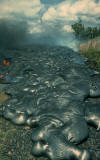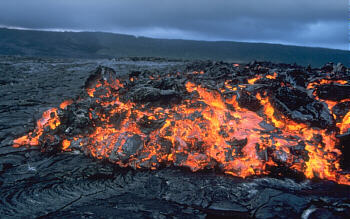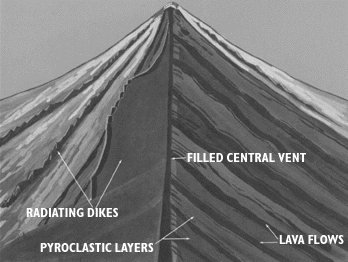
Old Earth Ministries Online Geology Curriculum© Old Earth Ministries (We Believe in an Old Earth...and God!) NOTE: If you found this page through a search engine, please visit the intro page first.
|
|
Geology - Chapter 11: VolcanoesVolcanoes are one of the more fascinating topics in geology. Volcanoes frequently grab the headlines when eruptions occur. Who can forget the 1980 eruption of Mount Saint Helens in Washington, or the stories of the ancient eruptions of Mount Vesuvius in Italy? Why did God choose to create our earth with volcanoes? Volcanoes served an important part in the past history of the earth. As rock material is eroded away, volcanoes replenish the materials lost, rebuilding the land. Volcanoes are living evidence that God created a living, ever-changing planet, that is self-renewing. |
Lesson Plan
Monday - Read Text Tuesday - Research Wednesday - Quiz Thursday - Review Friday - Test
|
|
Parents Information This lesson plan is designed so that your child can complete the chapter in five days. The only decisions you will need to make will be concerning the research task for Tuesday. It is up to you to determine if the student will simply fill in the answers, or provide a short essay answer. You will also need to determine the percentage that this research will play in the overall chapter grade, if any. |
|
|
If you have found this course useful, please consider a
donation, so that we can continue to offer
new curriculum. |
|
|
Without plate tectonics, and the new material deposited by volcanoes, our land would erode away, eliminating mountains and eventually all land. Our world would be covered in water over the entire globe.
|
|
Global Patterns of Volcanism During the last lesson, you learned about the Pacific Ring of Fire, and how most of the world's earthquakes are in this region. The ring of fire owes its life to tectonic forces. These tectonic forces are also responsible for volcanic activity. The "fire" in the name refers to the volcanoes that make up this feature. Because volcanoes involve moving bodies of molten rock, earthquakes are the natural result of this movement. Many of the earth's volcanoes are associated with tectonic plate boundaries. The type of volcano depends on the type of plate boundary. Divergent Plate Boundaries Volcanoes at divergent plate boundaries result in a basaltic rock. The temperature for basaltic lavas range between 900 and 1200 degrees centigrade. Because these lavas flow easily, they tend to move downslope and spread into depressions and valleys. Lava flows have been observed at speeds of up to 40 kilometers per hour (25 miles per hour), although speeds of 20 km/hr are more common. As the lava flow moves downslope, it loses gas and cools, gradually slowing. There are two
common types of basaltic lava flows. The first type is an VIDEO: AA Flow (Quicktime player required. To download player, click here.) As the flow cools,
it contracts and sometimes it develops a system of  The other type of lava flow is called a pahoehoe flow. These flows contain much more gas and are more fluid. They are usually less than 1 meter thick, and are the fast moving lava that can reach 40 km/hr. As the flow moves, the outer surface can harden, forming a glass-like crust. This crust can bunch up, forming a billowy form (see picture). Also common is a rope-like appearance. VIDEO: Pahoehoe flow (Quicktime player required.) Another type of
lava known as pillow lava occurs when lava is
As a general rule,
basaltic lavas are extruded in fissure eruptions. A fissure Sometimes the
spattered lava builds up around a vent, forming a spatter cone
(VIDEO:
Spatter Cone). This can occur when the lava flow is slow, yet
forceful. The smaller pieces of lava are shot out of the ground, and
in many cases the projectiles partially cool before landing. These
fragments of rock are called tephra. Tephra
can include fine grained material such as In large eruptions,
the ejected material continues to build, and form a broad cone called a
shield volcano (diagram).
With each eruption, the fluid lava flows down the slope, spreading into a
thin sheet. Shield volcanoes have a broad base, commonly over 100 km
in diameter (62 miles), with gently slopes. The internal Convergent Plate Boundary Volcanics Volcanoes that form at the convergent plate boundaries produce silica-rich lavas, otherwise known as granitic lava. These lavas are thick and do not flow , and they are relatively cool (650 to 750 degrees C) when compared to basaltic lavas. To understand the origins of these volcanoes, we must go back to plate tectonics. As an example, I'll use Mount Saint Helens. As an oceanic plate dives underneath a continental plate, the friction deep within the earth causes rocks to melt. The Gorda plate dives underneath the North American plate, deep underneath Washington, Oregon, and California. As the plate dives, there is slow heating of the basalt and ocean sediments in the descending plate. Eventually there is enough magma to begin rising through the crust. This rise is due to the density of the magma...it is less dense than the crustal rock. It can accumulate as a granite batholith, which you studied in Chapter 5. Or, it can be extruded in a volcanic eruption. This animation shows the process. The type of volcano
associated with granitic magma is called a composite One unique feature of composite volcanoes is the ash flow. This is a lateral movement of large masses of ash and lava particles. It is not a lava flow, and is best understood as a flow of suspended fragments and gas. As the magma works its way upward, the confining pressure that is containing the magma decreases. This causes the trapped gas bubbles to rapidly expand. Hence, the magma can literally explode.. Since it is denser than air, it flows over the surface as a thick dense cloud of hot ash. They can reach velocities of 60 km/hr (check wiki). When the ash flow stops, the particles of hot crystals, glass, and ash fuse together. This rock is known as a welded tuff. Ash-flow eruptions can be extremely catastrophic events. The ash flows from Mount Saint Helens travelled as fast as 130 km/hr, and extended 9 km from the volcano. The heat combined with the water also caused a mudflow, which gradually built as it moved downslope. The small Toutle River swelled to 1.5 km wide. The mudflow swept away over 100 homes, many cars, logging trucks, and other debris. Ash fall is another consideration. A vertical column of ash rose as high as 18 km above the mountain, and was carried downwind, settling like a soft gray snow over 1,000 km away from the volcano. Intraplate Volcanoes Not all volcanoes are associated with plate boundaries. The volcanoes of the Hawaiian Islands are from what is called a hot spot. There are hundreds of these hot spots in the Pacific plate. A weak spot in the oceanic crust, or a particularly molten portion of the mantle, may be the cause of these hot spots. They can also occur over continental crust. The Hawaiian hot spot is particularly fascinating. The tectonic plate that Hawaii sits on is moving to the northwest. However, the hot spot does not move. This means that after an island has formed, it moves off of the hot spot, and another island starts to form. This chain of islands formed by this hot spot extends from Hawaii all the way to Midway Island, a distance of over 1,500 miles. Here is an excellent animation depicting hot spot volcanoes. Supervolcanoes Some volcanoes are
so massive that they are called supervolcanoes.
There is no general rule for what is a supervolcano. The most well
known supervolcano is the
Yellowstone supervolcano, located in western Wyoming. Although
Yellowstone is a wonderful tourist location, the geology of the area For comparison, prior eruptions at Yellowstone have been 2,500 times the size of the 1980 Mount Saint Helens eruption. A major eruption of Yellowstone would possibly cause millions of deaths in the United States. Choose one of the two topic below and write a brief one page report:
1. Write a brief report on the Mount Saint Helens eruption. Be sure to cover the following topics: Ash Flow, Mud Flow, Plate Tectonics, Ash Fall
2. Write a brief report on the Yellowstone Supervolcano.
Utilize a search engine to locate the best webpages, or consult a textbook/encyclopedia. You may also use the links at the bottom of this page. Today you will complete a 10 question practice quiz. The link to the quiz will open a new window. You can come back here and check your answers. Do not click the Back button on your browser during the quiz. After the quiz, continue your research project, if necessary. Please review the terms in bold in the text, and ensure you have completed your research work from Tuesday. Today you will take the end of chapter test. Please close all other browser windows, and click on the link below. During the test, do not click on the Back button on your browser. After you have completed the test, you may proceed to Chapter 12 on your next school day. Please return to the introduction page for the link to the next chapter. Return to the Old Earth Ministries Online Geology Curriculum homepage. Helpful Links
Mount Saint Helens (Wikipedia)
USGS Report on Yellowstone's Future Yellowstone Volcano Observatory
|
 "aa" flow, pronounced "ah ah." An aa flow
has little gas, and is a slow moving flow typically several meters thick.
The surface of the flow hardens and forms a crust, while the interior
remains molten. An aa flow only moves a few meters per hour. As
it moves, the hardened crust is broken, resulting in a mass of angular
blocks, which are called clinker. The little
gas in the lava usually migrates outward. As the rock hardens, the gas
is trapped in the lava, forming bubbles in the hardened rock. These
holes in the rock are called vesicles.
"aa" flow, pronounced "ah ah." An aa flow
has little gas, and is a slow moving flow typically several meters thick.
The surface of the flow hardens and forms a crust, while the interior
remains molten. An aa flow only moves a few meters per hour. As
it moves, the hardened crust is broken, resulting in a mass of angular
blocks, which are called clinker. The little
gas in the lava usually migrates outward. As the rock hardens, the gas
is trapped in the lava, forming bubbles in the hardened rock. These
holes in the rock are called vesicles. 







 volcano. It is also known as a stratovolcano.
They are characterized by a steep-sloped cone around the volcanic vent.
There is usually a crater at the summit that marks the position of the vent.
As the magma body rises, it gives off gas, and pressure builds up underneath
the volcano. Eventually the volcano releases this pressure in an
eruption. Large quantities of ash and magma are erupted, sometimes in
an explosive event like Mount Saint Helens. After an eruption, the
magma chamber that had formed under the volcano will be at least partially
empty. This can result in the collapse of the summit, forming a large
basin at the top of the mountain. This basin is known as a
volcano. It is also known as a stratovolcano.
They are characterized by a steep-sloped cone around the volcanic vent.
There is usually a crater at the summit that marks the position of the vent.
As the magma body rises, it gives off gas, and pressure builds up underneath
the volcano. Eventually the volcano releases this pressure in an
eruption. Large quantities of ash and magma are erupted, sometimes in
an explosive event like Mount Saint Helens. After an eruption, the
magma chamber that had formed under the volcano will be at least partially
empty. This can result in the collapse of the summit, forming a large
basin at the top of the mountain. This basin is known as a
